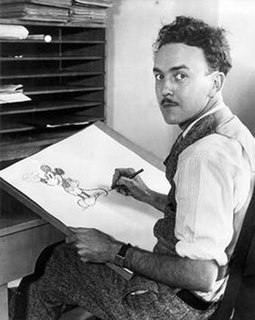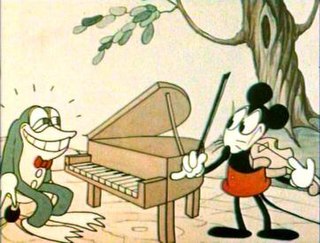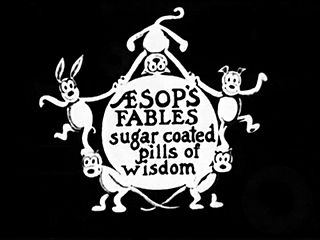Related Research Articles

Ubbe Eert "Ub" Iwerks was an American animator, cartoonist, character designer, inventor, and special effects technician, who designed Oswald the Lucky Rabbit and Mickey Mouse. Iwerks produced alongside Walt Disney and won numerous awards, including multiple Academy Awards.
The golden age of American animation was a period in the history of U.S. animation that began with the popularization of sound cartoons in 1928 and gradually ended throughout the late 1950s to late 1960s, where theatrical animated shorts began losing popularity to the newer medium of television animation, produced on cheaper budgets and in a more limited animation style by companies such as Hanna-Barbera, UPA, Jay Ward Productions, and DePatie-Freleng.

Felix the Cat is a funny-animal cartoon character created in the silent film era. The anthropomorphic black cat with his black body, white eyes, and giant grin, coupled with the surrealism of the situations in which his cartoons place him, combine to make Felix one of the most recognized cartoon characters in film history. Felix was the first character from animation to attain a level of popularity sufficient to draw movie audiences.
Hugh Harman and Rudolf Ising were an American animation team known for founding the Warner Bros. and Metro-Goldwyn-Mayer animation studios.

Merrie Melodies is an American animated series of comedy short films produced by Warner Bros. from 1931 to 1969, during the golden age of American animation. As with its sister series, Looney Tunes, it featured cartoon characters such as Bugs Bunny, Daffy Duck, Porky Pig and Elmer Fudd. Between 1934 and 1943, the Merrie Melodies series were distinguished from the black-and-white, Buddy or Porky Pig-starring Looney Tunes shorts by an emphasis on one-shot stories in color featuring Warner Bros.-owned musical selections. After Bugs Bunny became the breakout recurring star of Merrie Melodies, and Looney Tunes went to color in the early 1940s, the two series gradually lost their distinctions and shorts were assigned to each series more randomly.

Flip the Frog is an animated cartoon character created by American animator Ub Iwerks. He starred in a series of cartoons produced by Celebrity Pictures and distributed through Metro-Goldwyn-Mayer from 1930 to 1933. The series had many recurring characters besides Flip; including Flip's dog, the mule Orace, and a dizzy neighborhood spinster.
Van Beuren Studios was a New York City-based animation studio that produced theatrical cartoons as well as live action short-subjects from the 1920s to 1936.
Burton F. Gillett was a director of animated films. He is noted for his Silly Symphonies work for Disney, particularly the 1933 short film Three Little Pigs.

U.M. & M. TV Corporation was an American media company best known as the original purchaser of the pre-October 1950 short films and cartoons produced by Paramount Pictures, excluding Popeye and Superman. The initials stand for United Film Service, MTA TV of New Orleans, and Minot T.V.

Associated Artists Productions, Inc. (a.a.p.) was a distributor of theatrical feature films and short subjects for television. Through acquisitions, Associated Artists Productions' assets were purchased by United Artists, with its library eventually passing to Metro-Goldwyn-Mayer in 1981, following its purchase of United Artists and then Turner Entertainment Co., following its purchase of the pre-1986 assets of Metro-Goldwyn-Mayer and select United Artists assets. Turner Entertainment is now part of WarnerMedia. Though a short lived company, Associated Artists Productions lived a legacy of being best known as the copyright owner of the Popeye, and the color pre-1948 Looney Tunes and Merrie Melodies series of shorts by Paramount Pictures and Warner Bros. respectively, as their logos and trademarks were present at the beginning of each short's 16mm Eastmancolor prints syndicated for television in the 1960s.

Aesop's Fables is a series of animated short subjects, created by American cartoonist Paul Terry. Produced from 1921 to 1933, the series includes Closer than a Brother (1925), The Window Washers (1925), Small Town Sheriff (1927), Dinner Time (1928), and Gypped in Egypt (1930). Dinner Time is the first cartoon with a synchronized soundtrack ever released to the public. The series provided inspiration to Walt Disney to found the Laugh-O-Gram Studio in Kansas City, Missouri, where he created Mickey Mouse.

National Telefilm Associates was an audio-visual marketing company primarily concerned with the syndication of American film libraries to television, including the Republic Pictures film library, which did so well on cable television between 1983 and 1985, that it renamed itself Republic Pictures and undertook film production and home video sales as well.

Leo the Lion is the mascot for the Hollywood film studio Metro-Goldwyn-Mayer and one of its predecessors, Goldwyn Pictures, featured in the studio's production logo, which was created by the Paramount Studios art director Lionel S. Reiss.

Official Films, Incorporated (Inc.) was founded by Leslie Winik in 1939 to produce educational shorts. Soon, after buying some negatives of Public Domain Keystone Chaplin films, the company found itself in the 16mm/8mm home movie business. It obtained several dozen cartoons from Ub Iwerks and Van Beuren.

Rainbow Parade was a series of 26 animated shorts produced by Van Beuren Studios and distributed to theaters by RKO between 1934 and 1936. This was the all-color series and final series produced by Van Beuren.

Steamboat Willie is a 1928 American animated short film directed by Walt Disney and Ub Iwerks. It was produced in black-and-white by Walt Disney Studios and was released by Celebrity Productions. The cartoon is considered the debut of Mickey Mouse and his girlfriend Minnie, although both characters appeared several months earlier in a test screening of Plane Crazy. Steamboat Willie was the third of Mickey's films to be produced, but was the first to be distributed because Walt Disney, having seen The Jazz Singer, had committed himself to producing one of the first fully synchronized sound cartoons.
This is a complete list of animated films released theatrically starring Felix the Cat. "View" links are linked to a public domain file of the cartoon at archive.org or the official British Pathé archives at britishpathe.com.

Amedee J. Van Beuren was the producer of Frank Buck's first three films, as well as many cartoons and short films.

Circus Capers is a 1930 animated short film made by The Van Beuren Corporation and distributed by Pathé. The film, which featured the characters Milton & Rita, is part of the early sound cartoon series entitled Aesop's Sound Fables, though it is not based on an Aesop fable.

Western Whoopee is a 1930 animated short film directed by John Foster and Harry Bailey. It is part of the early cartoon series Aesop's Sound Fables. It was produced by The Van Beuren Corporation and released by the film company Pathé. It, like other Sound Fables at that time, features Milton and Rita, who resembles Mickey and Minnie Mouse greatly, so much so, Disney sued Van Beuren for the resemblance.
References
- 1 2 Slide, Anthony (2013). The New Historical Dictionary of the American Film Industry. Routledge. p. 179. Retrieved 2016-02-13.
- ↑ Hayde, Michael J. (2010-10-22). "TV Needs Cartoons!". Archived from the original on 2016-02-13. Retrieved 2016-02-13.